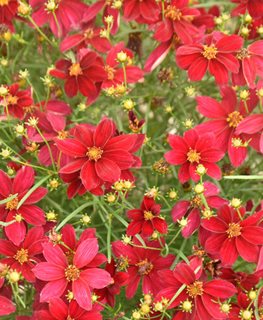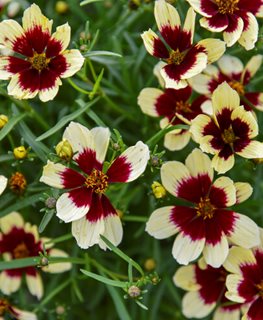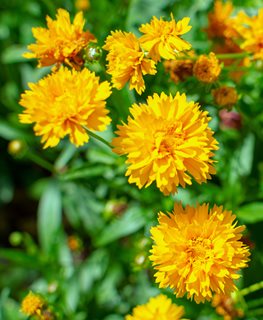Colorful Coreopsis: Easy-Care Blooms for Summer
Get tips for planting, caring for, and using this versatile, low-maintenance, native plant.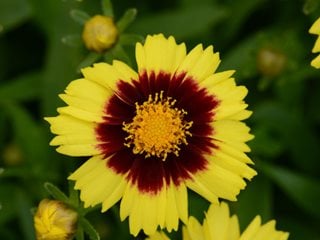
Uptick™ Yellow & Red Tickseed (Coreopsis hybrid). Photo by: Proven Winners
Valued for its long bloom season and fuss-free nature, coreopsis (tickseed) has become one of the most popular plants in the perennial garden, despite an unflattering name describing the appearance of its seeds rather than the beauty of its flowers. “Garden Superstar” would be a more fitting moniker for this gorgeous native prairie plant, which produces cheery, daisy-like blooms all summer long, thriving through sweltering heat and blazing sunlight.
As a bonus, this drought-resistant perennial will also attract a parade of pollinators to your garden, including bees, butterflies, and seed-eating birds. Although the native species of tickseed typically bloom in shades of yellow and gold, you’ll also find a wide array of cultivars offering a greater range of color choices, tidier growth habits, and larger flowers, giving you more options than ever before.
On this page: Basics | Types | Planting | Care | Pictures | Design Ideas
On this page:
- BASICS
- HOW TO PLANT COREOPSIS
- TYPES OF COREOPSIS
- COREOPSIS CARE
- COREOPSIS PICTURES
- FREQUENTLY ASKED QUESTIONS
- DESIGN IDEAS
BASICS
Botanical name:
Coreopsis spp.
Common names:
Tickseed
Hardiness Zones:
Typically 4-9, varies by species
Plant type:
Herbaceous pernnial or annual
Height:
6 inches (dwarf forms) to 8 feet tall
Exposure:
Full sun
Bloom time:
Usually early to late summer, varies by species and cultivar
Flowers:
Daisy-like flowers; single, double, or fluted petals; shades of yellow, gold, pink, white, red, and various bi-colors.
Foliage:
May be deeply lobed, lance-like,or fine and lacy, depending on the variety.
Fun fact:
“The Year of the Coreopsis” was declared in 2018 by the National Garden Bureau, which celebrates one perennial every year that meets its criteria for adaptability, genetic diversity, and versatility.

Designer Threads™ 'Heartstrings' threadleaf coreopsis. Photo by: Proven Winners.
TYPES OF COREOPSIS
There are about 80 species of Coreopsis, nearly half of them native to North America. Some are clump forming and others spread by rhizomes. Some of the most common species include:
- Clump-forming: C. grandiflora (large-flowered coreopsis) and C. lanceolata (lanceleaf coreopsis)
- Rhizomatous: C. auriculata (lobed or mouse-eared coreopsis), C. rosea (pink coreopsis), C. verticillata (threadleaf coreopsis), and C. tripteris (tall coreopsis)
- Annual: C. tinctoria (plains coreopsis) is another popular variety.
HOW TO PLANT COREOPSIS
When to plant:
In late spring, after the threat of frost has passed. Can also be planted in summer if kept well-watered until established.
Where to plant:
In full sun or light shade. Plants will bloom more prolifically in full sun (at least 6 to 8 hours daily).
Soil:
Don’t worry too much about the soil when planting coreopsis. It will tolerate just about any type of well-drained soil, including sandy and rocky soils.
How to plant:
When transplanting nursery-grown plants, dig a hole the same depth as the root ball and just a bit wider. Place the plant in the hole so the top of the root ball is at or just slightly above the soil level. Backfill, and then water thoroughly. To help retain soil moisture and protect the root system from temperature extremes, apply a layer of mulch around each plant.
Spacing:
12 to 20 inches, depending on the plant size at maturity
COREOPSIS CARE AND MAINTENANCE
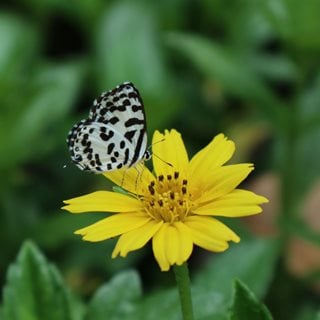
Photo by: Pics Man24 / Shutterstock
Watering:
Water young plants regularly until they become established. Mature plants will tolerate drought and only need watering during long periods of hot, dry weather. (See more drought-tolerant plants.)
Fertilizing:
Tickseed prefers growing in lean, infertile soil. Fertilizing or amending the soil is generally not needed and may actually inhibit flower production.
Pruning and deadheading:
Flowering will often begin to wane by midsummer, as the plant begins to devote its energy to seed development. Regular deadheading will encourage continued flowering but can be time-consuming, especially if you have a lot of plants.
An easier option is to shear plants back to half their height after they show signs of slowing down, which will usually promote a new flush of blooms while removing sprawling or untidy foliage. Although regular deadheading will prolong the bloom period, be sure to leave some spent flower heads if reseeding is desired.
"Coreopsis often re-seeds itself, so you'll be able to enjoy its cheerful blooms for years to come." — University of Florida Extension.
Dividing:
Some coreopsis (especially C. grandiflora and its cultivars) tend to be short-lived perennials and should be divided every two or three years—in early spring or fall—to extend their lifespan. You should also divide coreopsis if you notice that the center of the plant is beginning to die out or it starts to produce fewer or smaller flowers.
Pests and problems:
Coreopsis has few insect or disease problems. However, it may be susceptible to powdery mildew and other fungal diseases in areas with high humidity. See these tips for preventing and treating powdery mildew.
COREOPSIS VARIETIES
FREQUENTLY ASKED QUESTIONS
Is Coreopsis deer resistant?
Yes, Coreopsis is generally considered deer-resistant. While no plant is entirely deer-proof, tickseed contains natural compounds and has a texture that makes it unappealing to deer. Most gardeners find it rarely browsed, even in areas with high deer populations. Coreopsis is rated 'A' (rarely damaged) or 'B' (seldom severely damaged) by Rutgers University.
Does Coreopsis come back every year?
Yes, many varieties of coreopsis are perennials, meaning they return year after year. Some types, like Coreopsis tinctoria, are annuals and will need to be replanted unless they self-seed.
How do you keep Coreopsis blooming all summer?
To encourage continuous blooms, deadhead spent flowers regularly or shear plants back mid-season to promote fresh growth and a second flush of flowers.
Does Coreopsis attract ticks?
No, despite the common name “tickseed,” coreopsis does not attract ticks.
"Plants in the genus Coreopsis are sometimes commonly called lanceleaf tickseed in reference to the resemblance of the seeds to ticks." — Missouri Botanical Garden
WHAT TO PLANT WITH COREOPSIS & DESIGN IDEAS
Coreopsis are equally at home in formal and naturalized garden settings and are good companions with a wide array of other sun-loving perennials. Try some of these design ideas:
- Combine with purple coneflower, Shasta daisy, garden phlox, and yarrow for a colorful display in a cottage garden.
- Pair them with spiky flowers like speedwell, liatris, and salvia to add texture and visual interest. These and other flowers in the purple and blue color spectrum contrast beautifully with yellow coreopsis varieties.
- Create a meadow garden by planting with other native wildflowers and grasses such as Joe Pye weed, penstemon, black-eyed Susan, and Shenandoah switchgrass (Panicum virgatum ‘Shenandoah’).
- In a pollinator garden, team them up with other bee-friendly and butterfly-friendly plants to attract a wide variety of beneficial insects.
- Use the ferny foliage of threadleaf coreopsis to soften the appearance of bold-leaved foliage plants.
ABOUT THE AUTHOR
Anne Balogh is a longtime gardening writer and editor for Garden Design, with over 20 years of experience covering everything from container planting to landscape trends. She draws inspiration from her own Zone 5 garden in Illinois, where she experiments with hardy perennials and flowering annuals.
RELATED:
More on perennials and how to grow them
21 Easy Flowers
How to Start a Flower Garden
Summer Flowers

